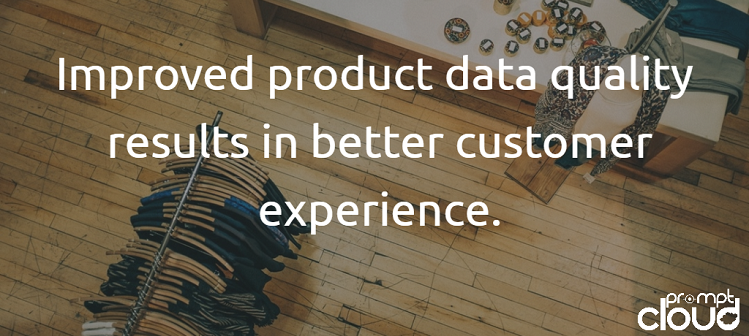
With significant adoption of big data, omni-channel retail and changing consumer dynamics, implementation of a robust organizational and data management system has become paramount for the large retailers. When retail business continues to grow rapidly, the complexity of tracking product data grows many folds. PIM systems come into play in these scenario to help retailers in both online and offline channel. In simple words Product Information Management Systems are the central repository of all the data related to the products – both structured and unstructured. These data range from core product data, SKU data, specifications, metrics, omni-channel data, digital assets, content and much more.
With a single location to store all data, retailers have the ability to view all information without logging into multiple tools – this improves quality, data management, and helps eradicate anomalies. Now, We’ll cover the importance of data quality and how PIM systems help.
Improving product data quality
Businesses who can link the product data to consumer behavior, buyer insights and decision-making process are the ones running at the forefront. And it’s well-known that the foundation of application of data lies on the quality of the data and that makes product data crucial for delivering great customer experience. Here are the factors that establish the data quality:
Precision
Data quality largely depends on the precision with which data is stored. Most importantly, apart from the inner channels of data acquisition, there are several other channels through which data gets captured. For example, you might be a retailer trying to capture competitor’s catalog to formulate your strategy or acquiring data from your channel partners for monitoring. In all these cases getting accurate data and finding out inconsistency remains a major roadblock.
Comprehensiveness
Another question that all serious retailers must ask is how much is comprehensive data? What type of data makes sense in terms of business and what type of data can be technically supported? Answering the questions related to completeness of data is important as it can impact the budget and investment required for data acqusition. As a data solutions company we can extract any data present on the web, but capturing the right attribute and understading its implication on business and technology should be taken into account.
Frequency
This is another most important aspect of data acquisition – how frequently the data should be acquired to maintain the quality and relevance. For example, aggregator portals would definitely want to reflect the exact price of the product as soon as it changes on the source site. Some might opt for live crawl, others would go for the extracting the data twice a day. The data might be complete and accurate, but if the data is not useful in terms of timeline, then this data won’t serve the purpose.
Consistency across channels
For retailers who are keen on omnichannel retail, the basic building block must be around integrating different systems. If the systems are in operating in silos, then the who strategy would fall apart. There are various legacy tools that are used to operate logistics, merchandising, promotions, sales, loyalty programs, etc. Apart from that in general there are custom-built apps which enable some level of synchronization. But, invariably these setup don’t talk to each other seamlessly and result in inconsistent communication in different channels. Here are two practical examples:
Example 1
Consumers are chased by a really attractive product advertisement for weeks on multiple web platforms. Finally, when the consumer decides to visit the offline store to try to the product, the salesperson is clueless about the availability. This is an example of how things can go wrong without an integrated system.
Example 2
This one more of a personal experience. Sometimes we see an ad on Facebook or Twitter and click on it to actually check out the product, but mostly end up on the website without any sign of the actual product. This happens because there is a gap between the team running promotion and the team handing merchandising who take of the product catalog.
How PIM systems help?
Product Information Management systems are the most important system for any retailer looking for uniformity across channels, business units and departments. PIM systems allow retailers to centrally store and manage information corresponding to all of their products and facilitate the communication among multiple department by bringing them onto a single platform. For example, in case of advertising, merchandising department and other channel partners, the product metadata available on the PIM system can be used to plan synchronized cataloging, promotion and sales.
Looking to bolster your PIM systems with formatted product data containing names, images & other details using EANs or ASINs? Contact us now!
How web data improves PIM systems
There are many application of using web data as an asset to drive retail business. Here are some the important use cases:
Pricing
It’s quite important to correctly price the products for optimum margins, and that requires steady evaluation and remodeling of pricing strategy. Although you might be already considering organisational data to factor in market condition, consumer behavior, inventory, etc. while implementing pricing strategy, it’s also equally important to consider the pricing set by the competitors for similar products as consumers can be price sensitive. Web data feeds for e-commerce product data can be used in this case.
Reseller management
Some manufacturers select resellers as a channel for product distribution and create terms to restrict the resellers from selling the products on the same set of e-commerce sites. This ensures that the seller is not trying to compete with others to sell the same product. But, it’s practically impossible to manually search the sites to find the resellers who are violating the terms. Apart from that, there might be some unauthorized sellers selling your product on various sites. Automating web data extraction to store this data in your PIM can help you save you resources.
Fraud Detection
In 2016, Apple came to know that most of the chargers and cables sold on Amazon as genuine products were in fact poorly made, with inferior or missing components, faulty design, and inadequate electrical insulation. In simple terms customers were purchasing counterfeit product by trusting Amazon. There’s no doubt that the counterfeit accessories were tarnishing Apple’s brand image among the customers. Web data extraction for specific products can be deployed to track and counter fraud.
Demand analysis
Demand analysis is a primary component for planning and shipping products. It answers important questions such as: Which product will sale fast? Which one will be relatively slower? To start off, e-commerce stores can analyze own sales figures to estimate the demand, but it’s always recommended that planning must be done much before the launch. That way you won’t be planning after the customers land on your site; you’d be ready with right number of products to meet the demand. One way to source this data can be crawling products from the classified sites and storing the same on PIM systems.
Monitoring search ranking
Many e-commerce players sell their product on their own website apart from marketplaces like Amazon and eBay. These popular marketplaces attract a huge number of consumers and sellers. The sheer volume of sellers on these platforms makes it difficult to compete and rank high for particular search performed on these sites. Search ranking in these marketplaces depends on multiple factors (title, description, brand, images, conversion rate, etc.) and needs continuous optimization. Hence, monitoring ranking for preferred keywords for the specific products via web data extraction can be helpful in measuring the result of optimization and perform time series analysis.
Campaign monitoring
It’s common for brands to engage with consumers via different platforms such as YouTube and Twitter. Consumers are also increasingly turning towards various web forums to express their views. It has become crucial for businesses to monitor, listen and act on what consumers say. You need to move beyond number of retweets, likes, views, etc. and look at how exactly consumers perceived your messages. Storing this information in the PIM system to drive customer engagement, measure satisfaction and tweak product strategy can be efficiently done.
By integrating web data in the PIM system, you’ll have the holistic overview of the product data and use that to carry out seamless integration of sales, marketing, operations, customer experience and product strategy.




















